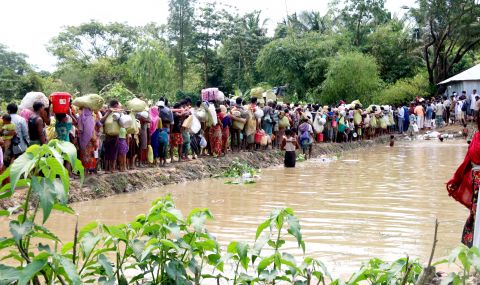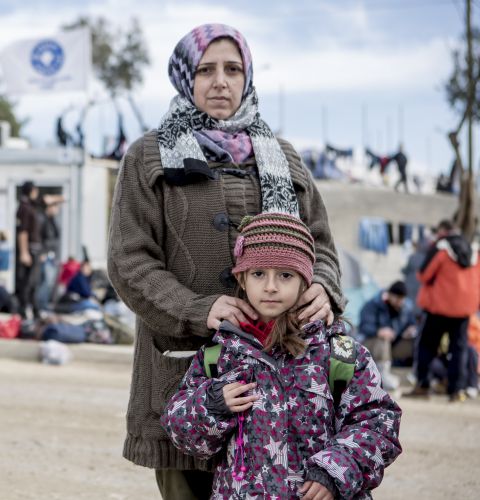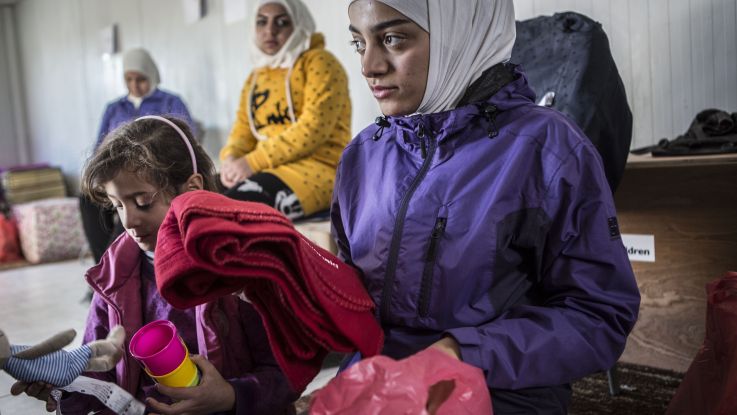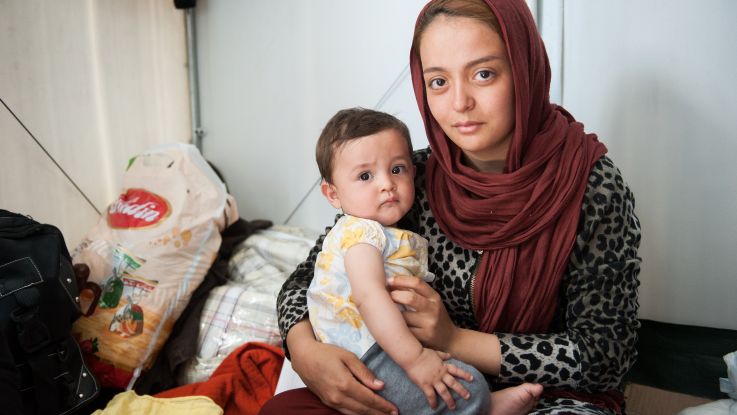Refugee and displacement crises
Refugee and displacement crises: key terms explained
What is a refugee?
A refugee is someone who has been forced to flee his or her country due to a conflict or a credible fear of persecution based on reasons of race, religion, political opinion, membership of a social group in that country and is seeking refuge in another state.3
What is an asylum seeker?
An asylum-seeker is someone who applies for protection as a refugee in another country and his or her request for refugee status has not been assessed or is yet to be processed.5
What is the meaning of 'internally displaced people'?
Internally displaced people are people seeking refuge from conflict or disasters but within the borders of their own country.6
What is the meaning of 'stateless people'?
Stateless people are those who do not have the nationality or legal citizenship of any country. People can become stateless for various reasons including changes in borders, emergence of new countries, and changes in law that could deprive certain people of their rights.7
What are 'climate refugees' or 'environmental refugees'?
The term 'climate refugees' or 'environmental refugees' does not exist in International law but is used in the media to describe groups of people who have been forced to leave their homes due to changes in their environment. The changes could be climate or meteorological-based disasters such as floods or a long-term, progressive change in their environment such as droughts, rise of sea-levels and increase in temperatures.4
Climate refugees are not offered the same legal protection as refugees. They do not fit into the legal definition of a refugee as they are not necessarily leaving their homes due to fear of persecution or conflict. Some climate or environmental refugees do not cross the border into any other country either, hence are not considered refugees. UNHCR prefers the term 'persons displaced in the context of disasters and climate change', instead of 'climate refugees'.

Rohingya refugees making their way to displacement camps in Cox's Bazaar in Bangladesh after fleeing from Rakhine, Myanmar.
ActionAid's approach to supporting refugees and displaced people
We support refugees and displaced people in the immediate aftermath of a humanitarian crisis, and over an extended period of time to help them rebuild their lives.
In the short term, we provide humanitarian aid; including food, safe drinking water, shelter and hygiene kits that contain clean underwear, soap and sanitary protection.
At displacement and refugee camps, we set up safe spaces for women where they can breastfeed in private, seek counselling and access emotional support. We set up watch committees to monitor and prevent violence against women.
We also provide cash transfers for women to decide and buy what they need the most.
In the long term, we help to rebuild communities and strengthen their resilience. For example, ActionAid trains women in leadership skills and disaster preparedness so that they are better equipped to lead their communities in times of crises.
Displacement and climate change
Increasing threats to food security and damage from weather-related disasters forces people to leave their homes and look for refuge elsewhere.
Climate-induced displacement occurs when rising temperatures cause sudden-onset, extreme weather-events such as floods and cyclones or influence long-term, slower-onset environmental changes such as droughts.
These in turn affect natural resources such as availability of water and farming land for the world's poorest people, threatening their safety, food security and livelihoods.9
However, the majority of the climate-related displacement is internal, with those affected remaining within their countries.10 Of the 28 million people who were internally displaced in 2018, 16.1 million relocated due to weather-related disasters such as extreme storms, floods and droughts.11
Migration caused by climate change occurs in a wider context, however, with pre-existing socio-economic and local governance exacerbating people's movements.
For example, climate change may impact the availability of resources which may lead to conflict or violence causing further dispersement of people.12
Conversely, those who have moved due to conflict or persecution may end up in regions that are climate change 'hotspots' and may suffer from secondary displacement.13
Displacement of women and girls due to climate change
Future climate-related disasters are inevitable14 and will drive women and girls away from their homes. 20 million of the 26 million people currently estimated to be displaced by climate change, are women.23
Women and girls are at an increased risk when disaster strikes.
- Women and girls are more likely to miss out on educational opportunities when they are displaced
- They are more likely to experience loss of income and livelihood.
- They are more vulnerable to violence, early marriage, adolescent pregnancy, rape and trafficking.15
Furthermore, displacement affects social support networks and community ties that are valuable to women and girls.16
Some women are reluctant to move to camps and shelters due to fear of violence and may risk staying in their disaster-prone regions.17
Our work supporting climate refugees in Somaliland
A severe lack of rain since 2020 has created and worsened the drought in Somaliland. Families and communities have been forced to leave their homes in search of food and water as crops are failing and livestock are dying.
There are 1.1 million internally displaced people in the region of Somaliland.
This climate crisis is affecting women and girls the hardest. Due to gender expectations, women and men in different contexts are forced to migrate for work or to displacement camps. In settings where it is dangerous for women and girls to travel on their own, this exacerbates their anxieties and risks of experiencing violence.
In the oppressive heat, with little protection from the sun, some women and girls prioritise the health of men and children, leaving themselves exposed to severe health consequences. There is limited, basic food and no toilets. Water is difficult to access, and every night girls go to sleep fearing an attack by strangers and wild animals.
Our support in Somaliland includes:
- Providing cash transfers, which women are using to buy food and water for their families
- Providing hygiene kits which contain period pads and soap
- Helping to build resilience in local communities through sustainable agriculture.
Supporting women and girls in refugee crises
Our work with refugees in Jordan and Lebanon
ActionAid Arab Regional Initative works with women's groups in Jordan and Lebanon to support both refugee women and local women.
These groups focus on ensuring women have economic independence through establishing a weekly market for goods produced by women, helping them set up small businesses, and also provide gym facilities so that women are able to exercise. They have also received training in how to tackle and report violence agaisnt women from our local partner NGOs.
Our work in refugee camps in Athens
ActionAid Greece started responding to the refugee crisis in September 2015 on the island of Lesvos, providing women friendly spaces and supporting some of the most vulnerable women and children in the refugee camps of Moira and Kara Tepe.
In the women friendly spaces, women were able to breastfeed in private, change their clothes, access hygiene kits including soap and sanitary towels, and get information in their own language from our cultural mediators.
The EU-Turkey deal
In March 2016, European leaders struck a deal with Turkey that meant refugees arriving in Greece would be sent back to Turkey if they did not apply for asylum or if their claim is rejected. As a result, border control was tightened and many of the refugee camps in Greece became closed camps.
ActionAid Greece responded by changing their focus from people on the move, to vulnerable people who would remain in Greece. Our teams in the camps of Schisto and Skaramaga in Athens provided pyschosocial support, information to refugee women about their rights in Greece and the EU, and they also run activities that the women requested, from learning English to keep-fit classes.

Lina is 24 years old, and comes from Hebron, in the West Bank of the Occupied Palestinian Territory.
ActionAid
Supporting refugees in Greece
Lina Abuaisheh, an aid worker from ActionAid Occupied Palestinian Territory, volunteered in Lesvos in 2016. She said:
“When ActionAid’s emergency response team called, seeking Arabic-speaking women to help refugees in Lesvos, I knew I had to go. I had prepared myself for what I might see, but no one could prepare me for the scale and intensity of the tragedy.
When I first arrived on Lesvos it was so chaotic and my colleagues and I were among the few people who could actually speak with the refugees.
Now, thank God, it’s better. When the refugees arrive they get a number and we, the Arabic and Farsi speakers, translate the announcements and explain to people what they need to do and where they need to go.
I came to Lesvos primarily to help with ActionAid’s mother and baby centres. Here women have a chance to relax for the first time in a long time. They can breastfeed, change their clothes, clean their babies and they can talk to someone about their difficult experiences.
I don’t buy it when people say ‘it's impossible’. There is a solution to this crisis and a way to save all those lives. There has to be.”

Sajida and her one-year-old baby Namat at an ActionAid women's space, Kara Tepe refugee camp, Lesvos.
Anna Pantelia/ActionAid
Supporting the most vulnerable refugee women from Syria
Sajida, who is 28 years old and from Syria, came to our women’s safe space on Lesvos after a traumatic journey. She shared her story.
Our city is gone. There’s nothing left any more. Not only was Assad bombing us from above, we were living in fear of ISIS too.”
“I left with my two children, as well as my husband, mother and brothers. But one of my brothers didn’t make it. He died in Syria.
We would have fled earlier if we could, but we didn’t have enough money. We were hoping that the war would end. The journey was really difficult. My children were shaking and crying. We were so scared because the sea got extremely rough before our boat reached the shore.”
Right now, I’m dreaming of living a life without fear. All I want is for my children to have one night’s sleep without fear.”
Conflict-related displacement
Our work during the Syrian refugee crisis
The war in Syria, which started in 2011, has claimed over 400,000 lives and injured more than 1 million people.
Violence and horrific human rights abuses, deepening poverty and the destruction of healthcare and education services has forced millions21 to cross treacherous waters and travel hundreds of miles in search of safety for themselves and their families.
As a result of this brutal conflict, 6.3 million people have been internally displaced and almost 4 million people are registered as refugees abroad, making this the biggest displacement crisis in the world.
The majority of refugees who have fled Syria are living in neighbouring countries, including more than a million registered Syrians in Lebanon and 660,000 in Jordan.
Footnotes
- 1https://www.unhcr.org/refugee-statistics/
- 3https://www.unrefugees.org/refugee-facts/what-is-a-refugee/
- 5https://www.unhcr.org/uk/asylum-seekers.html
- 6http://www.internal-displacement.org/internal-displacement
- 7https://www.unhcr.org/uk/stateless-people.html
- 4 https://www.iom.int/jahia/webdav/shared/shared/mainsite/about_iom/en/council/94/MC_INF_288.pdf
- 9https://www.un.org/development/desa/dspd/wp-content/uploads/sites/22/2018/05/9.pdf
- 10https://www.unhcr.org/uk/climate-change-and-disasters.html
- 11http://www.internal-displacement.org/global-report/grid2019/
- 12https://www.brookings.edu/wp-content/uploads/2016/06/Climate-Change-and-Internal-Displacement-October-10-2014.pdf
- 13https://www.unhcr.org/uk/climate-change-and-disasters.html
- 14https://www.eea.europa.eu/themes/climate/faq/how-is-the-climate-going-to-change-in-the-future
- 23https://static1.squarespace.com/static/559d276fe4b0a65ec3938057/t/55f6fe81e4b02545cc71df30/1442250369603/wen-briefing-net2.pd
- 15https://care.exposure.co/far-from-home
- 16https://www.fmreview.org/sites/fmr/files/FMRdownloads/en/FMRpdfs/FMR31/FMR31.pdf
- 17http://www.gdnonline.org/resources/WEDO_Gender_CC_Human_Security.pdf
- 18https://www.unhcr.org/58734dab7.pdf
- 20https://www.unhcr.org/58734dab7.pdf
- 21https://www.un.org/en/sections/issues-depth/refugees/
Page updated 6 February 2025



